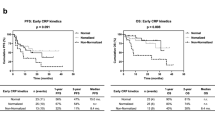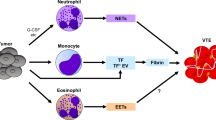Abstract
Purpose
The aim of the present study was to investigate the predictive value of the fibrinogen/albumin ratio index (FARI), neutrophil-to-lymphocyte ratio (NLR), and platelet-to-lymphocyte ratio (PLR) on the prognosis of patients with operable head and neck squamous cell carcinoma (HNSCC).
Methods
A cohort of 155 operable HNSCC patients were enrolled. Laboratory and clinical data were extracted from the patients’ electronic medical record. The optimal cut-off values were determined by receiver operating characteristic (ROC) curves analysis. Clinicopathological characteristics of patients were compared via Chi-square test. Survival curves were analyzed by Kaplan–Meier method. The prognostic factors were evaluated by univariate and multivariate analyses via the Cox hazards regression analysis.
Results
The median follow-up time was 31.7 months. An increased level of NLR was associated with later T stages, later N stages, and more advanced clinical stages(all P < 0.05). On univariate analyses, FARI, NLR, PLR, and N stage were correlated with progression-free survival (PFS) (all P < 0.05) as well as overall survival (OS) (all P < 0.05). And the clinical stage was only relevant to OS (P = 0.007). Multivariate Cox regression analysis revealed that FARI (HR 3.486, 95% CI 2.086–5.825, P < 0.001; HR 4.474, 95% CI 2.442–8.199, P < 0.001), NLR (HR 3.163, 95% CI 1.810–5.528, P < 0.001; HR 3.690, 95% CI 1.955–6.963, P < 0.001), and N stage (HR 1.718, 95% CI 1.058–2.789, P = 0.029; HR 1.777, 95% CI 1.024–3.084, P = 0.041) were independent prognostic factors for PFS and OS.
Conclusion
Our findings indicate that FARI and NLR are effective and convenient markers for predicting prognosis in operable HNSCC patients.



Similar content being viewed by others
References
Bray F, Ferlay J, Soerjomataram I, Siegel RL, Torre LA, Jemal A, Global cancer statistics, (2018) GLOBOCAN estimates of incidence and mortality worldwide for 36 cancers in 185 countries. CA Cancer J Clin 68:394–424
Pulte D, Brenner H (2010) Changes in survival in head and neck cancers in the late 20th and early 21st century: a period analysis. Oncologist 15:994–1001
Chauhan SS, Kaur J, Kumar M, Matta A, Srivastava G, Alyass A et al (2015) Prediction of recurrence-free survival using a protein expression-based risk classifier for head and neck cancer. Oncogenesis 4:e147
Ramalingam SS, Vansteenkiste J, Planchard D, Cho BC, Gray JE, Ohe Y et al (2020) Overall survival with osimertinib in untreated, EGFR-mutated advanced NSCLC. N Engl J Med 382:41–50
Diakos CI, Charles KA, McMillan DC, Clarke SJ (2014) Cancer-related inflammation and treatment effectiveness. Lancet Oncol 15:e493-503
Greten FR, Grivennikov SI (2019) Inflammation and cancer: triggers, mechanisms, and consequences. Immunity 51:27–41
Yao JJ, Zhu FT, Dong J, Liang ZB, Yang LW, Chen SY et al (2019) Prognostic value of neutrophil-to-lymphocyte ratio in advanced nasopharyngeal carcinoma: a large institution-based cohort study from an endemic area. BMC Cancer 19:37
Vernieri C, Mennitto A, Prisciandaro M, Huber V, Milano M, Rinaldi L et al (2018) The neutrophil-to-lymphocyte and platelet-to-lymphocyte ratios predict efficacy of platinum-based chemotherapy in patients with metastatic triple negative breast cancer. Sci Rep 8:8703
Zheng Y, Chen Y, Chen J, Chen W, Pan Y, Bao L et al (2019) Combination of systemic inflammation response index and platelet-to-lymphocyte ratio as a novel prognostic marker of upper tract urothelial carcinoma after radical nephroureterectomy. Front Oncol 9:914
Sheng L, Luo M, Sun X, Lin N, Mao W, Su D (2013) Serum fibrinogen is an independent prognostic factor in operable nonsmall cell lung cancer. Int J Cancer 133:2720–2725
Pichler M, Hutterer GC, Stojakovic T, Mannweiler S, Pummer K, Zigeuner R (2013) High plasma fibrinogen level represents an independent negative prognostic factor regarding cancer-specific, metastasis-free, as well as overall survival in a European cohort of non-metastatic renal cell carcinoma patients. Br J Cancer 109:1123–1129
Yu W, Wang Y, Shen B (2016) An elevated preoperative plasma fibrinogen level is associated with poor overall survival in Chinese gastric cancer patients. Cancer Epidemiol 42:39–45
Tan Z, Zhang M, Han Q, Wen J, Luo K, Lin P et al (2017) A novel blood tool of cancer prognosis in esophageal squamous cell carcinoma: the Fibrinogen/Albumin Ratio. J Cancer 8:1025–1029
Xu Q, Yan Y, Gu S, Mao K, Zhang J, Huang P et al (2018) A novel inflammation-based prognostic score: the fibrinogen/albumin ratio predicts prognoses of patients after curative resection for hepatocellular carcinoma. J Immunol Res 2018:4925498
Liang Y, Wang W, Que Y, Guan Y, Xiao W, Fang C et al (2018) Prognostic value of the fibrinogen/albumin ratio (FAR) in patients with operable soft tissue sarcoma. BMC Cancer 18:942
Hanahan D, Weinberg RA (2011) Hallmarks of cancer: the next generation. Cell 144:646–674
Grivennikov SI, Karin M (2010) Dangerous liaisons: STAT3 and NF-kappaB collaboration and crosstalk in cancer. Cytokine Growth Factor Rev 21:11–19
Schiffmann LM, Fritsch M, Gebauer F, Gunther SD, Stair NR, Seeger JM et al (2019) Tumour-infiltrating neutrophils counteract anti-VEGF therapy in metastatic colorectal cancer. Br J Cancer 120:69–78
Iseki Y, Shibutani M, Maeda K, Nagahara H, Tamura T, Ohira G et al (2017) The impact of the preoperative peripheral lymphocyte count and lymphocyte percentage in patients with colorectal cancer. Surg Today 47:743–754
Davuluri R, Jiang W, Fang P, Xu C, Komaki R, Gomez DR et al (2017) Lymphocyte nadir and esophageal cancer survival outcomes after chemoradiation therapy. Int J Radiat Oncol Biol Phys 99:128–135
Liu H, Wang H, Wu J, Wang Y, Zhao L, Li G et al (2019) Lymphocyte nadir predicts tumor response and survival in locally advanced rectal cancer after neoadjuvant chemoradiotherapy: Immunologic relevance. Radiother Oncol 131:52–59
Zmigrodzka M, Witkowska-Pilaszewicz O, Winnicka A (2020) Platelets extracellular vesicles as regulators of cancer progression-an updated perspective. Int J Mol Sci 21:5195
Xun Y, Wang M, Sun H, Shi S, Guan B, Yu C (2020) Prognostic analysis of preoperative inflammatory biomarkers in patients with laryngeal squamous cell carcinoma. Ear Nose Throat J 99:371–378
Chen L, Zeng H, Yang J, Lu Y, Zhang D, Wang J et al (2018) Survival and prognostic analysis of preoperative inflammatory markers in patients undergoing surgical resection for laryngeal squamous cell carcinoma. BMC Cancer 18:816
Simpson-Haidaris PJ, Rybarczyk B (2001) Tumors and fibrinogen. The role of fibrinogen as an extracellular matrix protein. Ann N Y Acad Sci 936:406–425
Sahni A, Simpson-Haidaris PJ, Sahni SK, Vaday GG, Francis CW (2008) Fibrinogen synthesized by cancer cells augments the proliferative effect of fibroblast growth factor-2 (FGF-2). J Thromb Haemost 6:176–183
Sahni A, Khorana AA, Baggs RB, Peng H, Francis CW (2006) FGF-2 binding to fibrin(ogen) is required for augmented angiogenesis. Blood 107:126–131
Wu M, Pan Y, Jia Z, Wang Y, Yang N, Mu J et al (2019) Preoperative plasma fibrinogen and serum albumin score is an independent prognostic factor for resectable stage II-III gastric cancer. Dis Markers 2019:9060845
Yeun JY, Kaysen GA (1998) Factors influencing serum albumin in dialysis patients. Am J Kidney Dis 32:S118–S125
Van Cutsem E, Arends J (2005) The causes and consequences of cancer-associated malnutrition. Eur J Oncol Nurs 9(Suppl 2):S51-63
Mantovani A, Allavena P, Sica A, Balkwill F (2008) Cancer-related inflammation. Nature 454:436–444
Gupta D, Lis CG (2010) Pretreatment serum albumin as a predictor of cancer survival: a systematic review of the epidemiological literature. Nutr J 9:69
Man YN, Chen YF (2019) Systemic immune-inflammation index, serum albumin, and fibrinogen impact prognosis in castration-resistant prostate cancer patients treated with first-line docetaxel. Int Urol Nephrol 51:2189–2199
Matsuda S, Takeuchi H, Kawakubo H, Takemura R, Maeda Y, Hirata Y et al (2021) Validation study of fibrinogen and albumin score in esophageal cancer patients who underwent esophagectomy: multicenter prospective cohort study. Ann Surg Oncol 28:774–784
Tang MJ, Ding SB, Hu WY (2019) Fibrinogen and albumin score changes during preoperative treatment can predict prognosis in patients with locally advanced rectal cancer. Gastroenterol Res Pract 2019:3514586
Li M, Bai J, Wang S, Zhai Y, Zhang S, Li C et al (2020) Prognostic value of cumulative score based on preoperative fibrinogen and albumin level in skull base chordoma. Onco Targets Ther 13:8337–8346
Gao QF, Qiu JC, Huang XH, Xu YM, Li SQ, Sun F et al (2018) The predictive and prognostic role of a novel ADS score in esophageal squamous cell carcinoma patients undergoing esophagectomy. Cancer Cell Int 18:153
Ying J, Zhou D, Gu T, Huang J, Liu H (2019) Pretreatment albumin/fibrinogen ratio as a promising predictor for the survival of advanced non small-cell lung cancer patients undergoing first-line platinum-based chemotherapy. BMC Cancer 19:288
Author information
Authors and Affiliations
Corresponding author
Ethics declarations
Conflict of interest
The authors declare no conflicts of interests.
Additional information
Publisher's Note
Springer Nature remains neutral with regard to jurisdictional claims in published maps and institutional affiliations.
Rights and permissions
About this article
Cite this article
Wang, S., Feng, Y., Xie, Y. et al. High fibrinogen-albumin ratio index (FARI) predicts poor survival in head and neck squamous cell carcinoma patients treated with surgical resection. Eur Arch Otorhinolaryngol 279, 4541–4548 (2022). https://doi.org/10.1007/s00405-022-07391-x
Received:
Accepted:
Published:
Issue Date:
DOI: https://doi.org/10.1007/s00405-022-07391-x




